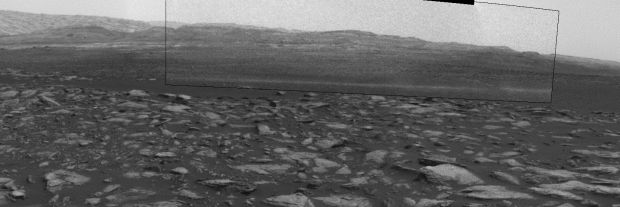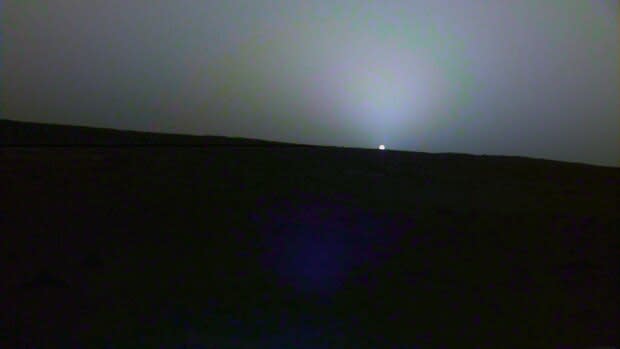'We've seen some weird stuff': Scientists release 1st findings from Mars InSight mission
Imagine living in a world where the nighttime temperature drops to –95 C and then barely reaches –10 C during the day. There is a constant threat of dust devils — small whirlwinds, similar to tornadoes. And the ground trembles.
For future humans exploring Mars, this could be their reality.
The first findings from NASA's Mars InSight mission, which landed on November 2018, were published Monday in the journals, Nature Geoscience and Nature Communications. The five individual papers studied weather conditions, seismic activity (marsquakes rather than earthquakes), geology, the planet's weak magnetic field and even sound.
Those findings are painting a picture of what living on Mars could one day look like.
"We've seen some weird stuff," said Don Banfield of Cornell University, who leads InSight's weather science and a lead author of one of the papers.
Banfield is particularly intrigued by one mystery on Mars: dust devils. The instruments on the InSight lander detected upwards of 10,000 "convective vortices," where air pressure suddenly drops and then rises, indicative that air is swirling nearby. But the only thing is, they can't see them. It's like an invisible mini tornado.
These vortices show up on InSight's pressure sensors, as well as the highly sensitive seismometer — which measures ground disturbances — but they're not kicking up dust to make a visible dust devil.
"You can certainly have a vortex go by and it doesn't kick up any dust, but it's a dusty place [where] we landed," Banfield said, referring to the lander's location called Cerberus Fossae. "There are tonnes of these things going by, and yet every time we've looked — and it's several hundred images that we've taken — we've seen absolutely zero dust devils."

And the mystery deepens: Using NASA's Mars Reconnaissance Orbiter's High Resolution Imaging Science Experiment (HiRISE), they can see fresh tracks around InSight, confirming these vortices have been swirling around the lander.
"I think it suggests to us that we don't understand dust-lifting on Mars," Banfield said.
And it's important that we do. On Earth water is the main driver of weather, but on Mars, it's the dust.
InSight has also done a fair bit of "listening" to Mars and has picked up infrasound, sound waves at frequencies lower than humans can typically hear, which is roughly 20 hertz. InSight can pick up sound as low as 10 hertz.
"Elephants could hear it," Banfield said. "I guess if we had elephants on Mars, they'd be able to hear the stuff that InSight can hear."
And this is something entirely new, he noted, which researchers hope to explore further to better understand the infrasound.
InSight was also able to image noctilucent clouds, similar to those rare, electric-blue ones seen in polar regions on Earth.

In general, clouds on Mars are quite remarkable, Banfield said.
The atmosphere on Mars consists of mostly carbon dioxide, or CO2, with some water vapour. (Earth's atmosphere is mainly nitrogen.)
But on Mars, the atmosphere is cold enough that the clouds might be frozen CO2. Basically, clouds on Mars could be dry ice.
Shaking it up
The seismometer also picked up marsquakes from deep below the ground.
On our planet, earthquakes are caused mainly by shifting tectonic plates, large sheets of rock. But Mars doesn't have tectonic plates.
Suzanne Smrekar, InSight's deputy principal investigator, said that, instead, the marsquakes could be caused by other sources, such as the cooling of the planet, volcanism or things slamming into the surface causing faults that weaken and shift.
Another hypothesis, Smrekar said, could be that water ice below the surface could be heated by magma, which pressurizes it and then allows it to escape through a crack in the rock. That in turn produces a unique frequency "like an organ" that has been picked up by InSight.
Watch and listen to marsquakes detected by InSight:
"Certainly some of the types of quakes that we see are consistent with some of the types of quakes caused by the motion of magma or motion of water under the ground," Smrekar said.
"That doesn't mean it's the right explanation. It just means it's a possibility."
But future Martians needn't worry: the quakes are believed to be so deep below the surface they wouldn't be detectable. At least, that's what the data has shown so far.
Clues to Mars's past
Scientists believe that billions of years ago Mars was a potentially habitable world, complete with an ocean covering most of the northern hemisphere and a magnetic field like Earth's protecting any potential life below.
But today, it is a dry, dusty planet, with barely any global magnetic field at all, rendering it inhospitable for life as we know it.
Though NASA's Mars Atmosphere and Volatile Evolution spacecraft (MAVEN) currently in orbit around the planet revealed that Mars did at one time have a magnetic field, scientists wanted to get more information from the ground, so they put an extremely sensitive instrument on board to measure magnetic fields.
And so far, InSight's findings have provided a few surprises.
"We were definitely surprised by how much stronger the [magnetic] field was: 10 times stronger," said Catherine Johnson, planetary scientist at the University of British Columbia and Planetary Science Institute in Tucson, who is a co-investigator on the international team studying magnetic fields on Mars and lead author of one of the papers.
"It's not unreasonably stronger, but because we didn't know, we were like, "Wow, OK!'"

As well, they found different sources of magnetization: from four-billion-year-old rocks buried kilometres below the surface to the changes between night and day to even magnetic pulses on the order of a second to minutes, which they didn't think they'd detect.
"That was a big surprise to many people who thought we just wouldn't see things like that," Johnson said.
In all, the findings are a meeting of the past and the future: it allows us to see the evolution of a planet that went from potentially habitable to devoid of any life we can detect, and it provides an opportunity to explore what future generations who might one day call Mars home can expect.
"I think we still have some work to do before we understand all the risks and challenges of putting people on Mars," Banfield said.


